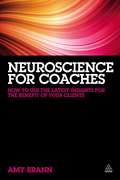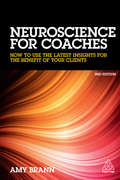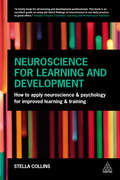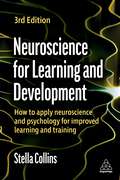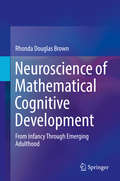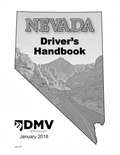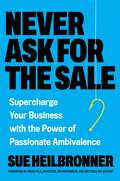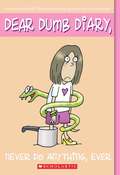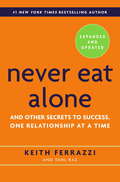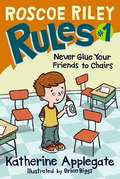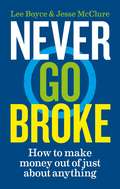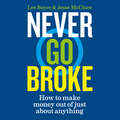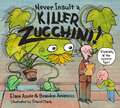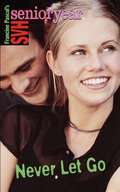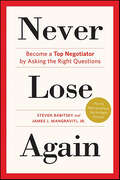- Table View
- List View
Neuroscience and Education: A Philosophical Appraisal (Routledge International Studies in the Philosophy of Education)
by Clarence W. JoldersmaThis volume makes a philosophical contribution to the application of neuroscience in education. It frames neuroscience research in novel ways around educational conceptualizing and practices, while also taking a critical look at conceptual problems in neuroeducation and at the economic reasons driving the mind-brain education movement. It offers alternative approaches for situating neuroscience in educational research and practice, including non-reductionist models drawing from Dewey and phenomenological philosophers such as Martin Heidegger and Merleau-Ponty. The volume gathers together an international bevy of leading philosophers of education who are in a unique position to contribute conceptually rich and theoretically framed insight on these new developments. The essays form an emerging dialogue to be used within philosophy of education as well as neuroeducation, educational psychology, teacher education and curriculum studies.
Neuroscience for Coaches
by Amy BrannThe world of coaching is competitive. Organisations want coaches who deliver results, and can prove it. Many coaching tools and techniques are now fairly well established - but how do they actually work? The coach who can answer this question credibly and convincingly is sought after. This ground-breaking book equips coaches with cutting edge neuroscience information that will help them deliver greater value to their clients. It covers the foundations that coaches need to be aware of and crucially, the ways they can use this new information effectively and practically in their everyday work. Readers will strengthen their kitbag of coaching tools and will be able to explain to their clients the neurological underpinning of the techniques they are using. No forward-thinking coach can afford to be ignorant of recent scientific developments: Neuroscience for Coaches will give them the practical knowledge they need.
Neuroscience for Coaches: How coaches and managers can use the latest insights to benefit clients and teams
by Amy BrannMany coaching tools and techniques are now well established, but how do they actually work? The third edition of Neuroscience for Coaches answers this question to help coaches and managers deliver greater value to clients and employees.Based on extensive research, Neuroscience for Coaches provides a clear explanation of the aspects of neuroscience that are relevant to coaching so coaches can describe to clients why particular techniques work and the benefits to be gained from using them. It also features interviews with Marshall Goldsmith, Susan Grandfield, Christian van Nieuwerburgh and Kim Morgan on topics including mindfulness and behaviour change in coaching.This fully updated third edition covers the latest neuroscientific research on key brain areas and their functions, such as the Prefrontal cortex and Amygdala which affect attention, processing and emotional regulation. With tips and insights throughout, it crucially demonstrates the ways in which coaches and managers who coach can use this information effectively and practically in their everyday work. Neuroscience for Coaches is a vital resource for improving coaching practice with the latest scientific developments, tools and techniques.
Neuroscience for Coaches: How to Use the Latest Insights for the Benefit of Your Clients
by Amy BrannMany coaching tools and techniques are now fairly well established, but how do they actually work? Neuroscience for Coaches equips coaches with information that will help them answer this question and therefore deliver greater value to clients. Based on over twelve years of research, this book provides a clear explanation of the aspects of neuroscience that are relevant to coaching so you can describe to clients from a neuroscientific perspective why particular techniques and methods work and the benefits to them.This fully updated 2nd edition of Neuroscience for Coaches includes new interviews with Marshall Goldsmith, Susan Greenfield, Christian van Nieuwerburgh and Kim Morgan, along with new material on oxytocin, goals and mindfulness. It covers the latest neuroscientific research and, crucially, the ways in which coaches can use this information effectively and practically in their everyday work. Neuroscience for Coaches is a vital resource for keeping up to date with recent scientific developments, tools and techniques in coaching.
Neuroscience for Learning and Development
by Stella CollinsNeuroscience for Learning and Development is about the psychology and neuroscience that underpins effective and successful training and learning. It introduces the latest research and concepts and suggests practical tools, techniques and ideas to improve how trainers train and how people learn. Readers will find new and more effective ways of working and will discover a sound basis for good practice. They will also discover the research that backs up what they are already doing well and evidence to support future projects and plans in order to make a convincing case to budget holders. Neuroscience for Learning and Development covers the design and delivery of face-to-face, online and virtual learning as well as how to create environments which make learning easier. It provides evidence to stop training and learning being seen as 'soft and fluffy' and will help trainers and L&D teams persuade the rest of their organization of their value. This book explains the science behind creative training delivery so that learners will be motivated, enjoy training, pay attention, remember what they learn and be able to apply it back at work. It explains the neuroscience of attention, memory and habits and how to make sure people learn what they need to learn. Readers will be able to distinguish the neuromyths from the neuroscience and will find out which elements of brain science offer evidence for current practice and as well as discovering new ideas to continue to develop their skills and practice.
Neuroscience for Learning and Development: How to Apply Neuroscience and Psychology for Improved Learning and Training
by Stella CollinsIn order to design and deliver effective Learning and Development (L&D) initiatives, it is essential to understand how our brains work to learn, process and retain information. Neuroscience for Learning and Development introduces the latest research and concepts in the field, equipping learning and development and training professionals with an understanding of some of the inner workings of the mind. Covering areas such as how to create effective learning environments, promoting motivation and how to make learning 'stickier' through using stories and narratives, this book offers practical tools and ideas that can be applied in a variety of contexts, from training sessions and coaching conversations, to lectures and presentations. Featuring insights from L&D practitioners who have applied such approaches in practice, readers will not only find new techniques to implement right away, but also discover the research that backs up what they are already doing well, enabling them to make convincing cases to budget holders.This updated second edition of Neuroscience for Learning and Development contains new chapters on digital learning and the importance of rest and sleep, as well as updated wider content and new material on mindfulness, learning through your senses, and the neuroscience of habits.
Neuroscience for Learning and Development: How to Apply Neuroscience and Psychology for Improved Learning and Training
by Stella CollinsNeuroscience for Learning and Development provides L&D professionals the tools and ideas to design and deliver effective initiatives with knowledge of how our brains process information.Using the latest research and concepts, this book covers areas such as motivation, habits and the link between sleep and learning. It demonstrates how to create effective learning environments and make learning 'stickier' with advancements in AI and digital learning, and through the use of stories. The practical tools and guidance can be applied in different contexts, such as digital learning, in-person training sessions and presentations.The third edition contains a new chapter on creating an autonomous learning culture. It explains the strategies, tools and techniques L&D professionals can use to encourage and support employees to learn in the flow of work. With insights from L&D practitioners who have applied these approaches in organizations such as The Open University, this edition is an indispensable book for creating and maintaining workplace learning that benefits people and organizations.
Neuroscience of Mathematical Cognitive Development: From Infancy Through Emerging Adulthood
by Rhonda Douglas BrownThis book examines the neuroscience of mathematical cognitive development from infancy into emerging adulthood, addressing both biological and environmental influences on brain development and plasticity. It begins by presenting major theoretical frameworks for designing and interpreting neuroscience studies of mathematical cognitive development, including developmental evolutionary theory, developmental systems approaches, and the triple-code model of numerical processing. The book includes chapters that discuss findings from studies using neuroscience research methods to examine numerical and visuospatial cognition, calculation, and mathematical difficulties and exceptionalities. It concludes with a review of mathematical intervention programs and recommendations for future neuroscience research on mathematical cognitive development.Featured neuroscience research methods include:Functional Magnetic Resonance Imaging (fMRI). Diffusion Tensor Imaging (DTI).Event Related Potentials (ERP).Transcranial Magnetic Stimulation (TMS).Neuroscience of Mathematical Cognitive Development is an essential resource for researchers, clinicians and related professionals, and graduate students in child and school psychology, neuroscience, educational psychology, neuropsychology, and mathematics education.
Neuroscience-Informed Counseling with Children and Adolescents: A Guide To Neuroscience-informed Practice
by Thomas Field Michelle Ghoston“This is a serious yet understandable book that needs to be on every counselor’s bookshelf. It makes a superb text for child and adolescent counseling courses or an excellent supplementary resource for theories courses. The case material is outstanding, and professors will find the content alignment with the CACREP Standards particularly helpful. The broad expertise of the authors speaks to a general audience, and they provide accurate, clear, and relevant information on neuroscience that is immediately useful. In short, this is a significant contribution to our profession.” —Allen E. Ivey, EdD, ABPP Distinguished University Professor (Emeritus) University of Massachusetts Amherst “This groundbreaking and comprehensive text is a must-have for any helping professional who works with today’s youth. This powerful resource contains the latest knowledge and research about neurocounseling and neuroscience, and the neuro-informed strategies and techniques are particularly helpful. This book is one that you will definitely want in your library.” —Lori A. Russell-Chapin, PhD Bradley University This innovative text is the first to illustrate how neuroscience concepts can be translated and applied to counseling with children and adolescents. Drs. Field and Ghoston discuss general principles for child and adolescent counseling before examining neurophysiological development from birth to age 18. They then provide in-session examples of neuroscience-informed approaches to behavior modification, play therapy, cognitive behavior therapy, biofeedback, neurofeedback, and therapeutic lifestyle change with diverse clients in a variety of settings. Each chapter contains knowledge and skill-building material for counselors-in-training; counselor educators; and practitioners in schools, hospitals, residential facilities, and outpatient clinics. Text features include learning objectives, alignment with the CACREP Standards specific to child and adolescent counseling, explanatory diagrams, reflection questions to prompt deep processing of the material, case vignettes to demonstrate how to apply neuroscience concepts to counseling work, and quiz questions to test knowledge of key concepts. In addition, the text includes an extensive neuroscience glossary. *Requests for digital versions from the ACA can be found on wiley.com. *To request print copies, please visit the ACA website here. *Reproduction requests for material from books published by ACA should be directed to permissions@counseling.org Thomas A. Field, PhD, is an assistant professor of psychiatry in the Mental Health Counseling and Behavioral Medicine program at Boston University School of Medicine. Michelle R. Ghoston, PhD, is an assistant professor at Wake Forest University in Winston-Salem, North Carolina.
Neuroscience-Informed Counseling: Brain-Based Clinical Approaches
by Lori A. Russell-Chapin Thomas A. Field Laura K. JonesAs professional counselors learn more about neuroscience, they need guidance on how to integrate this new knowledge into counselor education and counseling practice with clients. The purpose of this updated edition is to provide a comprehensive resource for translating and applying neuroscientific concepts to the theory and practice of counseling. The authors provide guidance as to how counselors integrate neuroscience into their work, with the hope of better understanding and identifying methods for effectively and responsibly incorporating key principles of neuroscience into the profession. This new edition incorporates the 2024 CACREP Standards as markers of learning, to ensure that CACREP-accredited programs have the information needed to apply neuroscientific concepts to all the major areas of counseling practice. This volume addresses the 2024 entry-level educational standards of the main accrediting body of the counseling profession, CACREP. Each of the eight common core areas of counseling knowledge and skills are covered (professional counseling orientation, social and cultural foundations, human growth and development, career development, helping relationships, group counseling and group work, testing and assessment, research and program evaluation). Several 2024 CACREP Standards that are integrated into the eight common core standards, such as the impact of crises, disaster, and traumatic events; the neurobiology of addictions; wellness and optimal performance; and psychopharmacology are also addressed. Some chapters also focus on doctoral-level 2024 CACREP standards for counselor education and supervision. To purchase print copies, please visit the ACA Store. Reproduction requests for material from books published by ACA or any other questions about ACA Publications should be directed to publications@counseling.org. ACA no longer provides complimentary print desk copies. Digital evaluation copies may be requested from Wiley by clicking the link above and completing the details about your institution and course.
Neuroscienze in aula. Sviluppo dell’intelligenza spaziale-visiva.
by Giuseppina De Vita Beatriz ManriqueL’obiettivo centrale del testo è quello di facilitare l’accesso al discorso sulla neuroscienza e come utilizzarla in aula, principalmente attraverso lo sviluppo dell’intelligenza spaziale-visiva proposta tanto da Gardner come da Beauport, due teorici delle intelligenze multiple. Si sviluppa l’uso della visualizzazione, l’abilità per arrivare all’astrazione degli spazi, come opzione di attività in classe progettate nell’ottica di un’educazione integrale. I temi presentati sono organizzati in nove parti: l’introduzione, un’intervista a una famosa maestra, la bilateralità cerebrale, un modello di analisi che parte dall’insegnamento delle lingue, il lavoro con le immagini, l’intelligenza visiva e la creatività, le immagini in aula, una proposta di attività con immagini e le conclusioni. In ciascuna parte si sviluppano differenti aspetti relazionati all’applicazione delle neuroscienze in una classe di lingue straniere, ma solo come esempio di applicazione poiché che l’obiettivo dell’autrice è di presentare, in maniera chiara, l’applicabilità della neuroscienza a tutte le aree di insegnamento e con molti esempi che facilitino l’estrapolazione dell’informazione ad altri campi. L’intervista con una maestra venezuelana di larghe vedute - Alicia Steiner – è uno dei migliori esempi, poiché mostra di fatto che quando si vuole, ci si prepara e si agisce, si raggiungono gli obiettivi. Le pratiche che vengono suggerite e gli esercizi che vengono descritti sono stati utilizzati in aula dalla stessa autrice, che offre la possibilità di espandere il loro utilizzo ad altre aree. Infine, nel testo sono raccolte varie attività visive come esempi di possibile utilizzo nel primo giorno di lezione. Le conclusioni includono, inoltre, riflessioni su tutto il processo del lavoro del docente secondo questo metodo.
Neuzuwanderung, sprachliche Bildung und Inklusion: Eine ethnographische Studie im Sekundarschulbereich (Inklusion und Bildung in Migrationsgesellschaften)
by Simone PlögerDie Studie untersucht, wie neu zugewanderte Schüler*innen an einer Hamburger Sekundarschule integrativ, d.h. sowohl in Regelklassen als auch einer Vorbereitungsklasse, beschult werden. Anhand von ethnographischen Daten wird durch Auswertungsmethoden der Reflexiven Grounded Theory aufgezeigt, wie es zu Prozessen der Inklusion und Exklusion durch sprachliche Bildung kommt. Herausforderungen zeigen sich in strukturell-organisationalen Hürden, während sich Chancen durch das inklusive Selbstverständnis der Schule ergeben, die ihren Unterricht an eine diverse Schüler*innenschaft angepasst hat. So hängt die Möglichkeit der Teilhabe am Regelunterricht letztlich vor allem von Faktoren ab, die alle Schüler*innen gleichermaßen und nicht nur neu zugewanderte betreffen.
Nevada Driver's Handbook
by Nevada Department of Motor Vehicles<p>This handbook has been written in an informal style for easy reading. As you read, you will find information on the knowledge, skills, abilities and attitudes you need to drive safely. <p>You will also find general licensing requirements, some basic traffic laws, explanations of signs and signals, material on driving under the influence and defensive driving tips. The knowledge test for your Nevada license is based on the information in this manual. <p>However, this handbook does not give the exact wording of traffic laws and it does not discuss all of them. For specific laws, please refer to the Nevada Revised Statutes (NRS). NRS copies are available in the public libraries and online at leg.state.nv.us/law1.cfm</p>
Never Ask for the Sale: Supercharge Your Business with the Power of Passionate Ambivalence
by Sue HeilbronnerA tech leader and executive coach's actionable guide for anyone looking to supercharge their selling prowess and close the deal with authenticity and integrity. Sue Heilbronner launched an executive coaching, facilitation, and speaking solo entrepreneurial venture which grew from zero to $1 million in annual revenue in six years. Now, she offers her insight into salespersonship in an irreverent, direct, and actionable guide to success in sales.Never Ask For The Sale goes beyond simple tips, and influences the reader&’s overall understanding of selling. Sue Heilbronner shares decades of experience, stories, tools, and exercises to coach people to be more successful at achieving their goals by aligning their work with their greatest strengths, and marketing that cohesive story with a winning sales strategy: passionate ambivalence. Heilbronner introduces this concept as the strategic yet honest practice of presenting oneself as selective in the work they take on while enthusiastic about their area of expertise. At the heart of the book is the notion that any successful seller, in any context, is fantastic at selling themself—whether that is within services in a solopreneur business, an early-stage startup, a college application, or a nonprofit mission. Never Ask For The Sale prompts deep self-awareness admixed with highly pragmatic calls to action at the intersection of coaching, personal growth, conscious leadership, and sales.
Never Do Anything, Ever (Dear Dumb Diary #4)
by Jim BentonHer best friend's a backstabber. Her worst enemy is a sweetheart. And her dog is just waiting for the right moment to seek his revenge. Why should Jamie even bother going to school? Why not? After a run-in with Mega-Popular Angeline, aka Pure Evil, Jamie reforms her selfish ways and becomes the decent human being she never thought she could be. But she quickly realizes that helping others kind of stinks. Is someone trying to thwart her attempts at irresistible inner beauty? Or will Jamie finally achieve the "I'm an angel" glow she knows will make Hudson Rivers fall madly in love with her?
Never Eat Alone, Expanded and Updated: And Other Secrets to Success, One Relationship at a Time
by Keith Ferrazzi Tahl RazThe bestselling business classic on the power of relationships, updated with in-depth advice for making connections in the digital world. Do you want to get ahead in life? Climb the ladder to personal success? The secret, master networker Keith Ferrazzi claims, is in reaching out to other people. As Ferrazzi discovered in early life, what distinguishes highly successful people from everyone else is the way they use the power of relationships—so that everyone wins. In Never Eat Alone, Ferrazzi lays out the specific steps—and inner mindset—he uses to reach out to connect with the thousands of colleagues, friends, and associates on his contacts list, people he has helped and who have helped him. And in the time since Never Eat Alone was published in 2005, the rise of social media and new, collaborative management styles have only made Ferrazzi&’s advice more essential for anyone hoping to get ahead in business. The son of a small-town steelworker and a cleaning lady, Ferrazzi first used his remarkable ability to connect with others to pave the way to Yale, a Harvard M.B.A., and several top executive posts. Not yet out of his thirties, he developed a network of relationships that stretched from Washington&’s corridors of power to Hollywood&’s A-list, leading to him being named one of Crain&’s 40 Under 40 and selected as a Global Leader for Tomorrow by the Davos World Economic Forum. Ferrazzi&’s form of connecting to the world around him is based on generosity, helping friends connect with other friends. Ferrazzi distinguishes genuine relationship-building from the crude, desperate glad-handing usually associated with &“networking.&” He then distills his system of reaching out to people into practical, proven principles. Among them: Don&’t keep score: It&’s never simply about getting what you want. It&’s about getting what you want and making sure that the people who are important to you get what they want, too. &“Ping&” constantly: The ins and outs of reaching out to those in your circle of contacts all the time—not just when you need something. Never Eat Alone: The dynamics of status are the same whether you&’re working at a corporation or attending a social event—&“invisibility&” is a fate worse than failure. Become the &“King of Content&”: How to use social media sites like LinkedIn, Twitter, and Facebook to make meaningful connections, spark engagement, and curate a network of people who can help you with your interests and goals. In the course of this book, Ferrazzi outlines the timeless strategies shared by the world&’s most connected individuals, from Winston Churchill to Bill Clinton, Vernon Jordan to the Dalai Lama. Chock-full of specific advice on handling rejection, getting past gatekeepers, becoming a &“conference commando,&” and more, this new edition of Never Eat Alone will remain a classic alongside alongside How to Win Friends and Influence People for years to come.
Never Enough: When Achievement Culture Becomes Toxic—and What We Can Do About It
by Jennifer Breheny WallaceThe definitive book on the rise of “toxic achievement culture” overtaking our kids' and parents' lives, and a new framework for fighting back. <p><p> In the ever more competitive race to secure the best possible future, today’s students face unprecedented pressure to succeed. They jam-pack their schedules with AP classes, fill every waking hour with resume-padding activities, and even sabotage relationships with friends to “get ahead.” Family incomes and schedules are stretched to the breaking point by tutoring fees and athletic schedules. Yet this drive to optimize performance has only resulted in skyrocketing rates of anxiety, depression, and even self-harm in America’s highest achieving schools. Parents, educators, and community leaders are facing the same quandary: how can we teach our kids to strive towards excellence without crushing them? <p><p> In Never Enough, award-winning reporter Jennifer Breheny Wallace investigates the deep roots of toxic achievement culture, and finds out what we must do to fight back. Drawing on interviews with families, educators, and an original survey of nearly 6,000 parents, she exposes how the pressure to perform is not a matter of parental choice but baked in to our larger society and spurred by increasing income inequality and dwindling opportunities. As a result, children are increasingly absorbing the message that they have no value outside of their accomplishments, a message that is reinforced by the media and greater culture at large. <p><p> Through deep research and interviews with today’s leading child psychologists, Wallace shows what kids need from the adults in the room is not more pressure, but to feel like they matter, and have intrinsic self-worth not contingent upon external achievements. Parents and educators who adopt the language and values of mattering help children see themselves as a valuable contributor to a larger community. And in an ironic twist, kids who receive consistent feedback that they matter no matter what are more likely to have the resilience, self-confidence, and psychological security to thrive. <p><p> Packed with memorable stories and offering a powerful toolkit for positive change, Never Enough offers an urgent, humane view of the crisis plaguing today’s teens and a practical framework for how to help. <p> <b>New York Times Bestseller</b>
Never Glue Your Friends to Chairs (Roscoe Riley Rules #1)
by Katherine ApplegateIf the kids can't sit still for the class performance, Roscoe's teacher could be in big trouble. Fortunately Roscoe has a plan to save her-a super, mega, gonzo plan! What could go wrong?
Never Go Broke: How to make money out of just about anything
by Jesse McClure Lee BoyceHow can you make money TODAY? How can you generate real cash this week? Never Go Broke isn't about stocks, shares and investment for the comfortable - it's a real-time lifeline for side-hustlers, downsizers, work-from-homers, the overstretched and anyone who needs to generate some extra cash right now but doesn't know how. This guide will show readers practical applications to make money right now and grow that money to either reinvest, repurpose, or help circumnavigate financial difficulties.Full of tips, tricks, advice and practical strategies you can use to make money by selling the everyday items all around you - nothing could be more useful in today's tricky economic reality.CONTENTSPART I: BUILD A RESALE POT FROM NOTHINGLesson 1: Selling items in your home right now Lesson 2: Carpe laziness - make money from people's apathy Lesson 3: Recycle the world - cash for trash Lesson 4: Simple ways to scoop 'free' cash online Lesson 5: Sell yourself! Make money from your talents PART II: LEARN YOUR RESALE BLUEPRINTLesson 6: Starting from scratch - everything has value Lesson 7: Resale traps to avoid and tips for success Lesson 8: How to value your precious time Lesson 9: Contacts and marketing are key Lesson 10: Spotting trends and recognising patterns PART III: PRACTICAL PLACES TO BAG PROFITSLesson 11: Car boot sales and swap meets - be first (or last) Lesson 12: Charity shops and thrift stores - get stuck in! Lesson 13: Antique centres, retro and vintage stores - knowledge is power Lesson 14: Estate and garage sales - untapped treasure Lesson 15: Specialty auctions - from lost luggage to coin craziness Lesson 16: The internet - the good, the bad and the ugly
Never Go Broke: How to make money out of just about anything
by Jesse McClure Lee BoycePerfect for anyone who needs to earn a bit of extra cash but doesn't really know how, Never Go Broke will tell listeners how to buy and sell all manners of goods, irrelevant of age or value, and turn them into a tidy profit. This guide will teach listeners practical applications to make money right now and grow that money to either reinvest, repurpose, or help circumnavigate financial difficulties.Full of tips, tricks, advice and practical strategies you can use to make money by selling the everyday items all around you - nothing could be more useful in today's tricky economic reality.Contents:BUILDING A RESALE POT FROM NOTHING including:Carpe lazy: Make money off people's lazinessRecycle the world: Trash for cashSell yourself! Make money from your talentsLEARN YOUR RESALE BLUEPRINT including:How to value your precious timeResale traps to avoid and tips to succeedSpotting trends and recognising patternsPRACTICAL PLACES TO MAKE PROFITS including:Thrift Stores and charity shops: Get stuck in!Estate and garage sales: Untapped treasureThe internet is your oyster (it's not just eBay)(p) 2021 Octopus Publishing Group
Never Insult a Killer Zucchini
by Elana Azose Brandon AmancioThis is one science fair you&’ll never forget! When Mr. Farnsworth, the science-fair judge, declares that he loves zucchinis, the Killer Zucchini is smitten. As the judge makes his way through the exhibits alphabetically—A (antimatter), B (bionic limb), C (cloning)—the Killer Zucchini tries to show his affection. But when Mr. F gets to K and admits he likes to eat zucchini with ranch dressing, the Killer Zucchini gets steamed and attempts to exact his revenge on the snack-loving judge using the other science-fair projects as his means to an end. Hilarious havoc ensues as the entire science fair is destroyed by his wrath. Engaging backmatter provides the science behind the science fair entries created by the characters in the story.
Never Kiss Your Roomate
by Philine HarmsWelcome to Seven Hills, the world’s most exclusive boarding school where only the best and brightest roam the hallowed halls. Being committed to your studies, service, and community doesn’t mean that you can’t break the rules now and again, right?But watch your back because lurking on the anonymous Chitter Chatter Blog is The Watcher—who can’t wait to reveal all the latest hookups, hot lists, and secrets around campus. The latest objects of The Watcher’s affection? Straight-off-the-train (but not exactly straight) insta-besties Evelyn and Seth.It doesn’t take long for Evelyn to realize she is inexplicably drawn to her gorgeous and standoffish roommate Noelle. Meanwhile Seth has eyes, and some serious heart palpitations, for budding thespian and school flirt Jasper. Just as things start to heat up, The Watcher strikes. Will the secrets revealed turn their happily ever afters into happily never afters?
Never Let Go (Sweet Valley High Senior Year #24)
by Francine PascalJeremy's never been one for drama. But that's all his life has been about lately. Jessica, Jade, Jade, Jessica, neither, both, neither. . . . It's time for him to make a choice. Unfortunately, when he does, the REAL drama is going to start.
Never Let a Fool Kiss You or a Kiss Fool You
by Mardy GrotheWhat do Mae West, John F. Kennedy, Victor Hugo, and H. L. Mencken have in common? They all indulged in chiasmus-a literary device in which word order is reversed to hilarious or poignant effect. When Mae West said, "It's not the men in my life, it's the life in my men," she was using chiasmus; when John F. Kennedy said, "Ask not what your country can do for you, ask what you can do for your country," he was doing the same. Dr. Mardy Grothe has compiled hundreds of examples of chiasmus in this whimsically illustrated collection, bringing this witty and thought-provoking device out of obscurity and into the public imagination. "There is plenty of delight in this overdue collection. " (Houston Chronicle)
Never Lose Again: Become a Top Negotiator by Asking the Right Questions
by Steven Babitsky James J. Mangraviti Jr.The Most Practical Book on Negotiating Ever WrittenNegotiating is an art. It's complicated. To become an exceptional negotiator traditionally requires years of experience in negotiations. But that doesn't mean that most people can't quickly and easily learn proven negotiating skill and techniques if someone shows them what to do. This book does exactly that. Never Lose Again reveals a simple but remarkably effective set of fifty questions that anyone can immediately use to become far better negotiators. The fifty questions apply to all types of negotiation situations, from conflicts like buying a home or car to business transactions of all kinds. Each question has been designed to put you in the best position possible, helping you to avoid tricks, break deadlocks, discover conflict and dispute resolutions, and find hidden deals in all types of negotiations.No other book on the market distills the key negotiation principles into such a simply, effective, and instantly usable form. By learning to use these questions, you can start thinking like expert negotiators and make better deals for yourself, your family, and your business.

